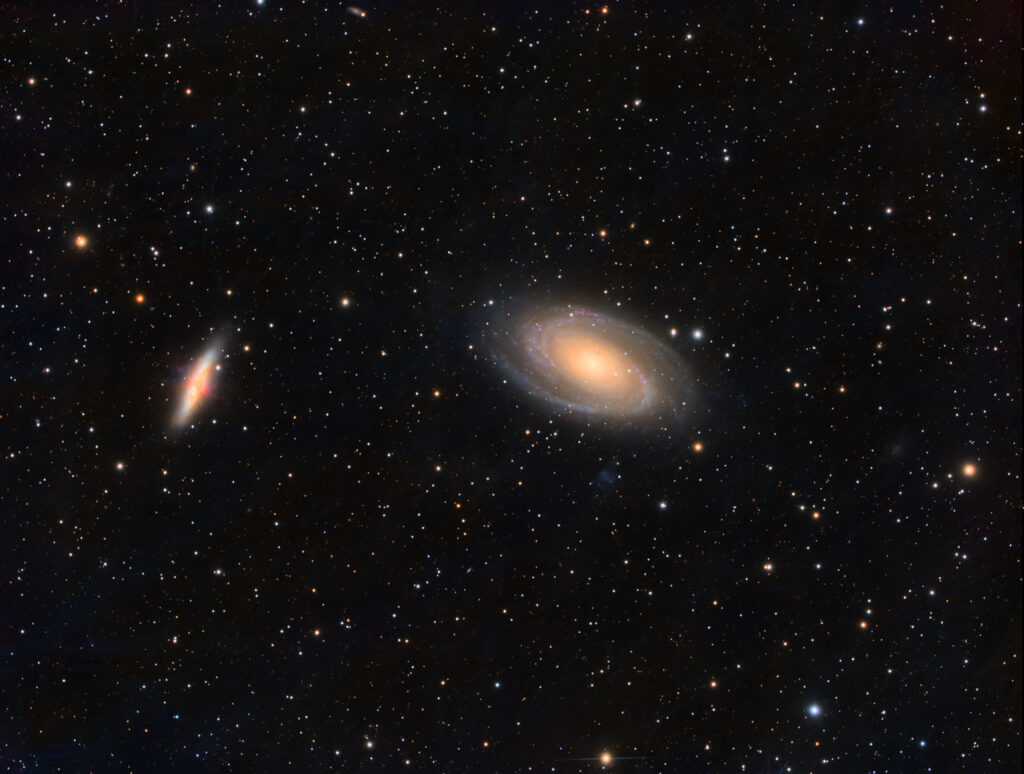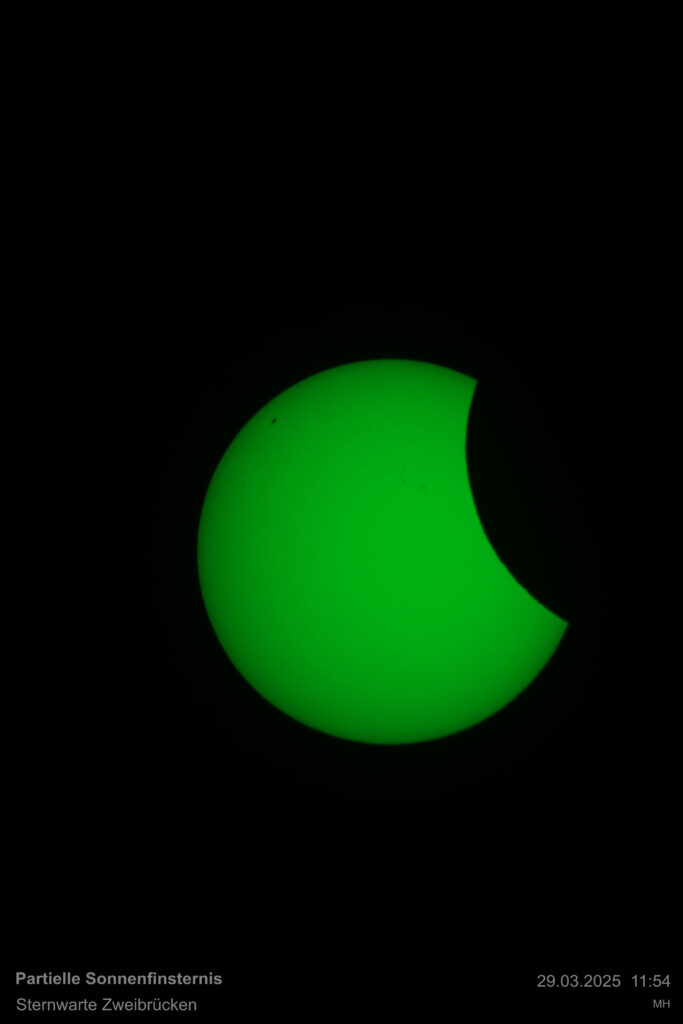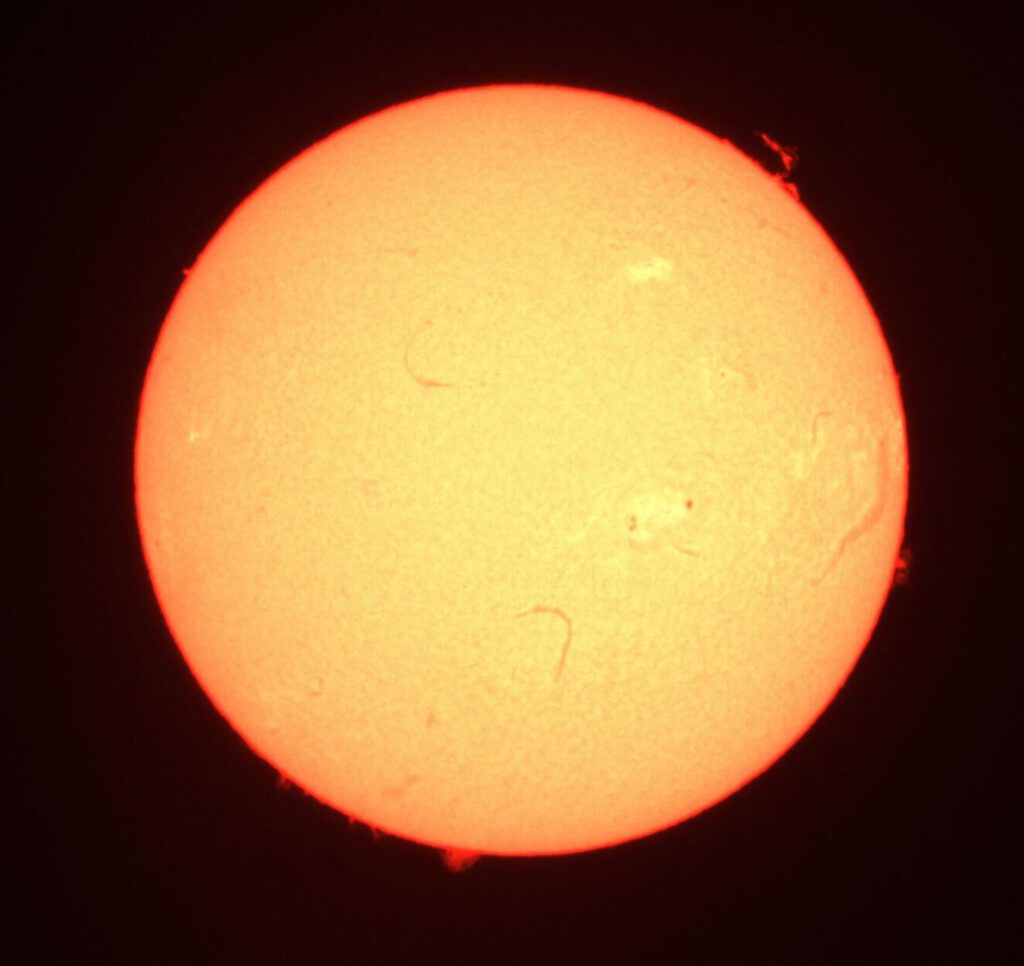Picture gallery
The lunar eclipse from the evening of 07.09.2025. For more detailed explanations, see the article: The lunar eclipse of 07.09.2025 at the observatory
The Omega Nebula, also known as Messier 17, is an extensive emission nebula region in the constellation of Sagittarius. It is located in the Milky Way at a distance of around 5,000 to 6,000 light years from us. New stars are constantly being formed in its interior: young, hot stars ionize the gas and make it glow. The star-forming region itself is relatively young, it is estimated to be only around 1 million years old. This makes M17 one of the active nurseries of the Milky Way, where stars are only just forming.
The picture was taken with a refractor of our observatory with a diameter of 5 inches (120mm) and a focal length of 900mm. The exposure time was 100x60s.
This image shows the galaxies Messier 81 (right) and Messier 82 (left). The image was taken with a 5 inch refractor whose focal length was reduced from 900 mm to 630 mm with the help of an optical component with the aim of enlarging the field of view, i.e. the section of the sky visible in the telescope.
A cooled astronomy camera with a resolution of 4640 x 3506 pixels was used. The total exposure time was 180 minutes in order to make even fainter structures visible.
Messier 81, often called Bode's Galaxy, was discovered in the 18th century by the German astronomer Johann Elert Bode. Its bright core, the center of the galaxy, in which a black hole with approximately 15 solar masses is hidden, is particularly striking. The distance is around 11.7 million light years
To the left is Messier 82, better known as the cigar galaxy. We see it almost from the side, which explains its elongated shape. The reddish, nebula-like structures are striking and, due to the distance of around 11.4 million light years, we observe them in a state that corresponds to 11.4 million years ago. During this period, an intensive phase of star formation took place there.
Together with other smaller galaxies, they form a gravitational group.
The partial solar eclipse of 29.03.2025. For more detailed explanations, see the article: The partial solar eclipse of 29.03.2025
Two recent photos taken by our member Tanja Lutz with a Smartscope Seestar S50.
In the left-hand image, the reddish emission nebula IC 434 in the constellation Orion can be seen below the bright star, which incidentally is the left-hand star of the belt in Orion. The dark silhouette in the foreground belongs to the Horsehead Nebula (B33), a striking dark nebula.
To the left of the bright star shines the orange-colored NGC 2024, better known as the Flame Nebula. It is also an emission nebula. Emission nebulae are clouds of interstellar gas that emit light in different colors.
Both nebulae are located at a distance of around 1500 light years. The image was exposed for a total of 50 minutes.
The open star cluster M45 can be seen in the image on the right. The Pleiades, also known as the seven sisters, the daughters of the Titan Atlas from Greek mythology, is a young star cluster at a distance of approx. 440 light years. In this image, which was exposed for a total of 47 minutes, the remains of the nebula from which the stars were formed can still be seen.
An image of comet C/2023 A3 Tsuchinshan-ATLAS taken on the evening of October 16, 2024 by our member Otmar Becker on a Smartscope Seestar S50.
In addition to the dust tail, a so-called anti-tail, in this case the plasma tail, can also be seen. An antitail is a phenomenon that can sometimes be observed in comets and, due to its position in relation to the sun, points in the opposite direction to the normal tail as seen from Earth in this image.
Comets typically have two types of tails:
- Dust tail: This consists of dust particles that are pushed away by sunlight. The dust tail is usually curved and diffuse, as the dust particles are of different sizes and move at different speeds.
- Plasma tail (also ion tail): Driven away from the sun by the solar wind, a continuous stream of charged particles (mainly protons and electrons). It always points directly away from the sun.
The counter-tail occurs under special conditions and is a projection effect. Due to the perspective from Earth, it appears as if this tail is spreading "backwards", i.e. towards the sun.
The eastern part of the Cirrus nebulaeThe two nebulae, also known as the Veil Nebula, in the Swan with the designation NGC 6992, together with the components not shown here, are the remnants of a supernova that occurred around 8000 years ago. Its distance is 1500 to 2500 light years. The image was taken on August 25, 2024 with a total exposure time of 100 minutes using a 5" refractor with a focal length of 900 mm.
Northern lights over Zweibrücken. Auroras are caused by interactions between solar wind and the Earth's atmosphere. The solar wind, a stream of charged particles from the sun, hits the Earth's magnetosphere. Some of these particles travel along the magnetic field lines to the Earth's surface, where they interact with gases in the atmosphere, such as oxygen and nitrogen. In the process, the gases emit energy in the form of light, which causes the auroras. They typically occur near the magnetic poles, and in exceptional cases, when the sun is very active, even as far away as our latitudes, as happened tonight.
Above a picture from the night of 11.05.2024 at 0:45 am. The location was about 15km south-southeast of Zweibrücken.
Image of a larger group of spots in the visible light of the sun. The image was taken on May 9, 2024 at 12:46 on the observatory's refractor with 900mm focal length and 5 inch diameter. A solar filter was used, which blocks 99.999% of the sunlight. The exposure time was 1/2500s at ISO-200 with a standard DSLR. At the top right is a magnification of the group of spots.
Appropriate protective measures are essential when observing the sun. Therefore, never look at the sun without these measures under any circumstances.
The comet Pons-Brooks, photographed by our member Otmar Becker on March 3, 2024 at 8:15 pm. A Smartscope ZWO Seestar S50 was used. A total of 60x10s was exposed. See also the explanation under Comet 12/P Pons-Brooks in March/April 2024
Comet C/2023 P1 was named after Hideo Nishimura, an amateur astronomer who discovered the comet on August 12, 2023. C/2023 P1 (Nishimura) probably originates from the Oort Cloud, which is located at the edge of our solar system.
Comet Nishimura will be closest to Earth on September 12, 2023. Its distance to Earth will then be approx. 125 million km (approx. 6.6 light minutes). It will be at perihelion on 18.09.23 (the shortest distance to the sun on its orbit). After that, it will move away again in our solar system on an elliptical orbit, unless it breaks up due to the energy of the solar radiation.
The comet's color is caused by diatomic carbon, which is produced by the interaction between sunlight and organic material on the comet's surface and decomposes when exposed to sunlight.
The comet is currently visible in the morning sky in the east before sunrise. The photo was taken from the observatory with the reflecting telescope. The tail is just visible in the image. The comet was obscured in the telescope's line of sight by a university building until 5:35 am. As a result, the light of dawn was already very noticeable in the image and details of the tail were no longer clearly visible. Image processing, however, made the fine structures of the tail visible.
In our latitudes comet C/2023 P1 (Nishimura) can be seen in the East in the hours before sunrise. It will make its closest pass by Earth on Sept. 12, 2023 within 125.4 mill. km, approximately 6.6 light minutes, (77.9 million miles).
Comet Nishimura will reach perihelion (the closest point to the Sun in its orbit) on Sept. 18 and, if it does not disintegrate by the Sun's energy, will then swing around the Sun and head back out into the Solar System.
Comet C/2023 P1 is named after Hideo Nishimura of Japan, the amateur astronomer who discovered the comet on Aug. 12, 2023. It probably came from the Oort Cloud, a distant region of the Solar System.
Comets like C/2023 P1 have green comas, but this color does not extend to their tails. The green color is caused by diatomic carbon, a highly reactive molecule that is created from the interaction between sunlight and organic matter on the comet's head and then almost immediately destroyed again by the Sun's energy before it can move far away from the nucleus. The nucleus of a comet is only a few km across and cannot be observed. What is seen as a greenish blob is the coma.
The comet is presently visible in the Eastern morning sky before sunrise. The photo has been taken with the mirror telescope C14 of our observatory. On the original image, the comets tail can barely be recognized. Because of a building in the telescope sight-of-line to the comet, it became visible only after 05:35 hours and the twilight was already quite noticeable and masked partially the fine fins in the tail. Image processing, however, allowed to render the details visible. Source: Partially from The Planetary Society (https://www.planetary.org/articles/how-to-see-newly-discovered-comet-nishimura
08.09.2023; W.A. and M.H.
The image above shows the type II supernova SN2023ixf in the galaxy M101, 21 million light-years away, discovered by the Japanese amateur astronomer Koichi Itagaki on May 19, 2023 at 19:45 UT.
Unfortunately, the conditions were not optimal, the moon and stray light interfered. The image was taken on the night of May 31, 2023 and was exposed with 15x60s on a Takahashi refractor TSA-120, 900mm focal length, with an EOS250D at 1600 ISO. (Detail of the original image)
The image above was taken on 01.03.2023 at around 18:50 in front of our observatory. It shows Jupiter and Venus (from left to right) at a distance of approx. 40.5 arcminutes, as well as the dome. The closest approach of the two planets took place on 02.03.2023 at around 12:00 noon with a distance of approx. 32.5 arc minutes, i.e. approximately the diameter of the full moon.
I used an EOS250D with an EFS 18-55 lens plus remote shutter release on a conventional photo tripod. 1600 ISO, exposure time 1/8s, aperture 5.0, with 31mm and manual focus.
Video Bolide on 14/15/12/2022 top left
Video of a meteor recorded by an AllSky7 camera at Zweibrücken Observatory on the night of December 14/15, 2022 shortly after midnight. The meteor belongs to the Geminids, a meteor shower that appears to come from the constellation of Gemini. However, the cause of the meteor shower is interplanetary dust clouds originating from the asteroid Phaethon. The Earth passes through these dust clouds every year in the days around 14.12. The dust particles burn up as they enter the atmosphere, causing trails of light. The camera is maintained by our member Rouven Ipser.
Video of a meteor recorded by an AllSky7 camera of the observatory in the night of 14th/15th December 2022 shortly after midnight. The meteor belongs to the Gemini shower which apparently originates from the constellation Gemini ("The Twins"). In reality, the Earth crosses the dust clouds which emanated from an asteroid named Phaethon. The dust particles evaporate when entering the atmosphere causing a light trace. The camera is operated by our member Rouven Ipser.
The photo of the sun was taken with our solar telescope through a Fabry-Perot filter, which serves as a bandpass for the H-alpha line. This allows the prominences at the edge of the sun to be made visible. These can reach up to several 100,000 km into space. For comparison: the diameter of the sun is approx. 1.4 million km. The black dots and thread-like formations are sunspots. Here the temperature of the sun's surface is lower than in the other areas. Image taken on 27.06.2022.
This image was taken with our Sun telescope through a Fabry-Perot filter which acts as a bandpass at the H-alpha line and renders the prominences at the rim at the Sun visible. These may extend up to some 100 000 km into space. The diameter of the Sun is approximately 1.4 Mill. km. The spots and filaments represent cooler areas of the Sun's surface. Image taken on 06/27/2022.

Comet Neowise on 12.07.2020 photographed with our C14 reflector telescope. In July 2020, its distance to Earth was approximately 120 million km. Together with the parameters of our telescope, the apparent diameter of the coma can be calculated as 50,000 km. The coma is gaseous. However, the comet's solid nucleus is much smaller and its diameter has been estimated by professional astronomers to be about 5 km. The image also shows how the tail develops from the coma.
Photo of Comet Neowise taken on 07/12/2020 through our mirror telescope C14. In July 2020 its distance to Earth was about 120 Mill. km. The photo shows the so-called coma which is a gaseous structure. It can grow to a size of 2-3 Mill. km. Using the parameters of our telescope, we estimate the apparent size to be about 50 000 km. The nucleus of the comet, i.e. its solid core, is much smaller. It was estimated by professional astronomers to be 5 km in diameter. One can also see how the tail emanates from the comet's coma.























